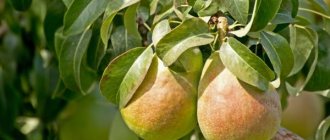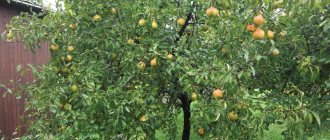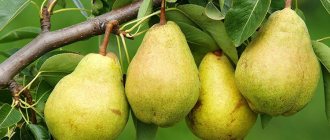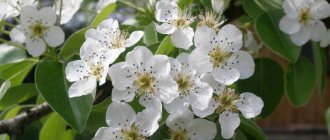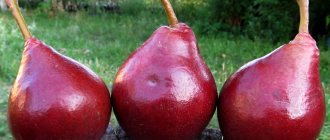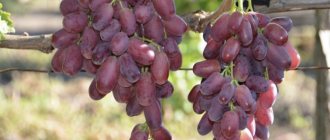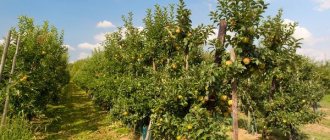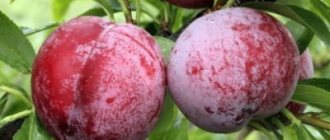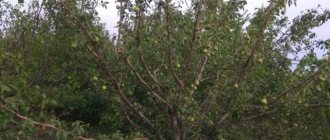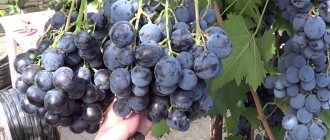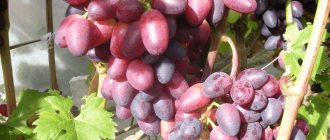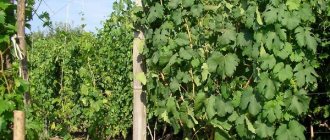Bere Bosc pears.
Description of the variety
Bere Bosc is one of the autumn ripening varieties. Pear is also known by the names Bere Alexander and Bere Apremont. The variety is widely distributed in different regions of countries such as:
- Russia;
- Ukraine;
- Moldova;
- Georgia.
Characteristics of wood
Trees of medium size. The height of an adult pear does not exceed 4-5 meters. The crown is not prone to thickening and has the shape of a pyramid. The bark on the shoots is gray-brown. The leaves are large, oval-shaped and dark green in color.
During the flowering period, the tree is covered with large white flowers. They attract many insects, thereby pollinating the pear.
Description of fruits
Fruits of Bere Bosc.
The variety is large-fruited and the weight of one pear ranges from 150 to 250 grams. The fruits have an elongated, bottle-shaped shape. During the ripening process, the pear acquires a golden-rusty color. The taste of the fruit is sweet, with a characteristic taste of almonds and spices. The pulp is very juicy and aromatic.
Fruit maturity occurs in the first half of September. After being picked from the tree, the harvest can be stored for about a month. The fruits tolerate transportation well.
Pears: growing and care (video)
At the same time, the Bere Bosk pear variety, popular in our country, has a significant number of advantages, including very high quality fruits and large fruit sizes. In addition, over time, the yield of a tree can increase significantly. The variety is characterized by low demands on soil and climatic conditions in the growing region, and shows the highest productivity on light soils with a sufficient amount of irrigation. The popularity and demand of “Bere Bosk” is also due to the plant’s sufficient resistance to damage by many fungal diseases and scab.
Sources:
https://fermer.blog/bok/sad/plodovye-derevya/grusha/sorta-grush/osennie-sorta-grush/5692-grusha-bere-bosk.html https://fermilon.ru/sad-i-ogorod /derevya/grusha-bere-bosk-harakteristika.html https://dachadecor.ru/derevya/agrotechnika-viraschivaniya-grushi-bere-bosk
Reviews
The yield of this pear makes me happy every year. There are so many fruits that we cannot cope with them ourselves. Therefore, in the fall I distribute gifts to all relatives. It is worth noting that pears actually tolerate transportation very well.
Yaroslav
Makhachkala
The tree has been growing for me for a long time; 20 years ago I bought a dacha, and it was already on the plot. The fruits have an incredible taste. For me personally, there is no more delicious variety. And the kind of jam that comes out of them is simply beyond words.
Tamara
Vladikavkaz
The most delicious pears I've ever eaten. Both fresh, and most importantly, they do not lose their flavor in juice, preserves and jam. I really like the variety, even though the tree is capricious.
Valentina
Taganrog
Growing rules
Growing conditions directly affect the taste and external qualities of the fruit. So with the Bere pear it is difficult to ignore growing standards.
Planting pear seedlings
- Some Bere varieties are capable of self-pollination, but the yield is low. To get a truly decent harvest, it is necessary to plant pollinators nearby - pears of other varieties.
- Bera is very demanding when it comes to watering. Most varieties do not tolerate drought. It is necessary to water 3-4 times per season, but abundantly (30 liters per square meter). And to prevent the root system from starting to rot, it is necessary to make a good drainage layer before planting to drain away all excess water.
- Fertilizers are applied from 3 years after planting (if the soil was well fertilized during planting). Fertilize pears in spring and autumn. During the summer, this is done if there are a lot of fruits, on the contrary, there are few, or if the tree has been ill (to maintain its strength). Organics are added once every 3 years, and minerals can be added 2 times a year.
- The Bere pear is a vigorous tree, so pruning is carried out every year. From the age of 2 years, formative pruning is carried out. At the same time, sanitary pruning must be carried out annually, in autumn or early spring. All diseased, frozen or dry branches should be cut off, and the cut areas should be treated with garden varnish.
- Beres rarely boast resistance to frost. For the winter, these trees are usually insulated so that they do not die in the event of sudden severe frosts. The trunk is tightly wrapped with any insulating material. The root system can be protected by mulching. The mulch is spread into the tree trunk circle in a layer of 30-35 cm.
The agricultural technology for growing Bosco pears is not very complicated, so the return on investment in this variety is very high.
Landing
The optimal time for planting is autumn. This approach allows you to reduce the waiting time for the first harvest by a year. The optimal site should be well lit and protected from the wind.
Important! Bosc pear loves sandy-chernozem soils, so in poorer areas fertile soil is poured into planting holes.
The optimal planting pattern is 5x5 m. Holes are dug 1x1 m and 70 cm deep (or even more) about 2 weeks before the expected planting date. The excavated soil is mixed with a large amount of humus or rotted manure. Then a mound of prepared soil mixture is poured into the hole, on which the seedling is placed, carefully straightening its roots. A peg is stuck nearby, to which the tree must be tied.
As the hole is filled in, the soil is watered, achieving its natural compaction. An earthen roller is formed around the trunk, which will prevent water from spreading during watering. In the first year, it is optimal to pour 2 buckets of water under the tree each time. In arid regions, cover the soil with a layer of mulch to retain moisture.
In arid regions, cover the soil with a layer of mulch to retain moisture.
The gardener needs to pay special attention to watering the trees. In most cases, it is enough to do it once a week. 2-3 years after planting, you can limit yourself to monthly abundant watering. Water directly from a well or well is not suitable; it is better to use water that has been settled in an open barrel, ensuring careful care.
Fertilizers for Bere Bosc pears are selected depending on the composition of the soil. In the first year, when adding a large amount of organic matter to the planting hole, you can completely abandon fertilizing. Next, potassium and phosphorus mineral fertilizers are applied, and mullein solutions are also used. Green manures such as burdock and nettle, which can enrich the soil with nutrients valuable for pears, are considered excellent neighbors.
When it comes to pruning, follow these simple rules:
- The formation of the pear crown is carried out twice a year: in spring and autumn. In the fall, formative pruning is performed, and in the spring, sanitary pruning is performed.
- When pruning branches in the autumn, they try to give the crown a symmetrical shape by shortening branches that are too long.
- Young growth in the tree trunk circle is removed, as it serves as an excellent shelter for overwintering parasites.
- The lowest branches are not pruned, allowing them to grow to any width.
- When cutting large branches, it is advisable to treat the cuts with a special putty.
Pear pruning scheme
Small trees are completely wrapped in agrofibre for the winter. At a more mature age, only the trunks are insulated by wrapping them with cardboard or any other heat-insulating material.
Attention! In winter, it is advisable to cover the tree trunk circle well with snow to the maximum possible height.
Diseases and pests
The pear is loved by many pests common in the Black Earth Region and other regions. Each year you will need to do the following:
- Carefully inspect each tree, identifying affected areas.
- Perform the first preventive spray before the buds open, then again during flowering, and a third time 2-3 weeks before harvest.
Detected areas of tree disease damage are carefully cleaned, and cut branches, bark, and leaves are only burned. In autumn, fallen pear leaves should not be left under trees, as many insects nest in them. If there is nowhere to put all the leaves, then they should be buried in the soil, which will lead to the death of most pests. In the autumn, after the leaves fall, the pear trunks are carefully treated with whitewash, to which fungicides are necessarily added.
In the autumn, after the leaves fall, the pear trunks are carefully treated with whitewash, to which fungicides are necessarily added.
The popular pear variety “Bere Bosk” is not demanding on growing conditions, but grows especially well and bears fruit abundantly when cultivated on light and loose soils with moderate moisture levels. When cultivated in shaded and marshy areas, the plant will produce minimal yield.
When growing Bere Bosc pears, you must adhere to the following recommendations:
- in the first time after planting, it is very important to provide young plants with conditions for good growth, and it is also recommended to trim the crown;
- at the initial stage of cultivation, special importance is attached to feeding plants with nitrogen-containing fertilizers and organic matter;
- the variety places increased demands on the presence of potassium in the soil, therefore, in areas with depleted soils, the dose of potassium fertilizer should be increased by approximately 15-20%;
- in dry weather conditions, pear trees should be watered at least three times in the amount of three buckets of water per plant;
- in the phase of maximum plant productivity, it is recommended to keep the soil in the tree trunks under the so-called “black fallow”;
- in the autumn period, it is necessary to carefully dig up the soil in tree trunk circles to a depth of no more than 10-12 cm;
- between rows, autumn digging of soil is carried out to a depth of no more than 15-17 cm.
We also invite you to familiarize yourself with the varietal characteristics of the August Dew pear.
Tags: Bosc, cultivation, pear, feature, late
About the author: admin4ik
« Previous entry
Landing
When planting Bere Bosc pears, it is worth considering that this variety is best grown on fertile soil and with sufficient sunlight. More materials on this topic can be found in the articles selected below.
How to plant a pear tree correctly
At what distance to plant pears?
How to choose pear seedlings
How to replant a pear
Harvest and storage
Ripe fruits begin to be collected in early September. Pears ripen unevenly, stay well on the branches and rarely fall off on their own. It is recommended to pick the fruits slightly unripe, since they will fully ripen under storage conditions. Remove the pears along with the stalk. This procedure is carried out in dry weather.
The Bere Bosca pear is considered one of the most common varieties. And this is not surprising, because the fruits have excellent taste and commercial qualities, and the crop itself is not picky about growing conditions. By following a number of simple recommendations given above, everyone can replenish their garden with the Bere Bosca variety.
Care
Trees of this variety are easy to care for, but it is very important to ensure that the pear receives a sufficient amount of moisture. By clicking on the links below, you can get acquainted with useful tips for growing this variety.
How to care for a pear Pruning a pear Pruning a columnar pear Treating a pear from diseases and pests Feeding a pear How to water a pear
Characteristics
A young tree begins to bear fruit 6–8 years after planting. Propagated only by seed rootstock or with the help of seedlings of mainly cultivated varieties.
A 17-18 year old tree brings a yield of 80-100 c/ha , a 30-year-old tree – up to 180 c/ha.
High yields are demonstrated by the following pear varieties: Orlovskaya Krasavitsa, Gera, Rogneda, Skazochnaya and Pamyati Zhegalova.
Full ripening of the fruit occurs in mid-September from the 5th to the 15th.
The fruits ripen unevenly, but can hang on the branches for a long time without falling off, even in strong winds.
Trees are relatively safe from frost only in the Krasnodar Territory or on the Black Sea coast . In other regions, sub-zero temperatures of 28–30 degrees can destroy a tree completely down to the roots.
According to these indicators, the Bere Bosc variety is one of the least winter-hardy pear varieties. Also, this tree variety has poor drought resistance. Transportability and storage of fruits are good.
But when left in the refrigerator for a long time, the fruits lose their pleasant taste , and the pulp turns from tender to dry and brittle.
Read also: How to make quince jam
The variety is free pollinated . For the best result of fruit set on the site or, in extreme cases, in the nearby area, you need to have pollinating varieties.
The tree as a whole is unpretentious to growing conditions and soil composition.
Grows and bears fruit well in light sandy soils.
The juicy and sweet taste of the fruit is rated 4.8 points on a five-point scale.
The pear has very delicate creamy pulp with a pleasant melting consistency.
There are almond notes and a characteristic fragrant smell.
Chemical composition of fruits:
| Compound | Quantity |
| Sugar | 9,0% |
| Ascorbic acid | 4.6 mg/100 g |
| Solids | 14,7% |
| Acids | 0,2% |
Diseases and pests
Pear Thumbelina practically does not suffer from fungal diseases. Even in conditions of high humidity and severe epidemics. But the tree is not protected from pear borer and rust.
In the articles below you can find information about protecting plants from pests and diseases.
Dangerous Pear Pests
Pears often suffer from pests, they affect the leaves, bark and fruits.
In this article, we have selected 11 of the most harmful insects that harm pear trees, and also ways to destroy them.
Diseases of pear trees
To get what they cherish, gardeners have to work hard, and the reason for this is pear diseases.
Read about 19 common pear diseases and how to combat them.
Planting and caring for Bere Bosc pear
You need to buy 1-2 year old Bere Bosk seedlings. They adapt faster. Pears are grown in the southern regions, so planting is done in the spring before the buds swell or in October. No time is spared in preparing the land:
- the site is dug up;
- remove the roots of perennial weeds;
- add humus and mineral fertilizers;
- sand is added to improve the structure.
Landing rules
An adult tree has a wide pyramidal crown, so seedlings are planted at a distance of 3-4 m from buildings, trees, and fences. The holes are dug deep (1 m) and wide (0.8 m). The pear root system is powerful and requires nutrients for its formation.
When purchasing a seedling, it is assessed. Signs indicating its quality:
- there is no damage to the bark, it is smooth and even;
- the length of the roots is at least 25 cm, the number of main roots is at least 3-5 pcs.;
- the roots are not overdried, they do not break when bent, and are white when cut.
A stake is driven into the center of the hole, and garden soil mixed with sand, humus, superphosphate, and ash is poured into a mound. A seedling is placed on it, its roots are straightened and covered tightly with soil, leaving the root collar outside. There should be at least 5 cm from it to the ground level.
The trunk is tied to a support in 1-2 places. It should be located on the south side of the peg. A one-year-old seedling is shortened to 0.8-0.9 m. In two-year-olds, all skeletal branches are shortened by ⅓. Reduce the length of the central conductor. Its crown should be 20 cm higher than the top tier of branches.
Seedlings in the first 2 years of life require special attention. Mandatory measures for their care:
- regular watering;
- cleaning the tree trunk circle from weeds;
- feeding;
- loosening the soil;
- preventive treatments against pests and diseases.
Watering and fertilizing
The pear tree loves watering. The fruit-bearing Bere Bosk tree is watered up to 5 times per season. If it is hot in the summer and there is no rain, then the amount of watering is increased. Water consumption when watering at the root is 30 l/m². In arid regions, drip irrigation is organized, and the soil is mulched to reduce evaporation.
The feeding schedule is based on the age of the tree. For the first 2 years, the pear does not need fertilizer. The fertilizers that were placed in the hole during planting are sufficient. Starting from the 3rd year, the tree is fed:
- in the spring, spray with a solution of complex fertilizer (“Nitrophoska”, “Ammophos”);
- humus is added to the soil annually - 6-10 kg/m²;
- In the fall, ash is added to the tree trunk circle.
Bere Summer
Also check out these articles
- How to trap a swarm of bees and transplant them into a hive
- What not to feed rabbits
- How to get rid of rats in a chicken coop?
- Keeping guinea fowl at home
Summer Bere varieties bear fruit from the end of July and throughout August. Grown primarily for sale or fresh consumption. One of the most popular summer varieties is Bere Letnaya. Its main difference is in the fruits. They are large, elongated pear-shaped and can weigh up to 280 g, while the same summer “Giffard” and “Zolotaya” produce fruits of 80-100 g maximum. The peel is always thin, smooth, yellowish with dots over the entire surface. The pulp is light, tender and sweet in taste, with a high juice content.
Bere Bosc variety is a very famous pear
Important!
Summer Bera pear varieties are soft and susceptible to shedding after full ripening, so they are harvested without delay or a few days before full ripening. They are suitable for food even at the stage of technical maturity.
Bere Letnyaya was first discovered in the Vinnitsa region. The tree begins to bear fruit already 4-5 years after planting. The variety is frost-resistant, so it can be grown not only in the southern but also in the middle regions. A 15-year-old tree can produce yields of 120 kg per year. Pears ripen around August, but it is recommended to remove them 7-10 days before ripening so that they are not yet very soft, this way they will be better stored.
Also in the summer, such types of Bere as “Clapp’s Favorite”, “Bere Giffard”, “Bere Golden” ripen.
The history of the creation of the Lyubimitsa Klappa variety
This pear comes from America (Massachusetts), it appeared thanks to T. Clapp in 1860. According to the main version, the variety originated from free pollination of a Forest Beauty seedling, but it is possible that it is a spontaneous hybrid of the Williams variety. The second option for the name of the pear is Clapp's Favorite.
In 1947, the variety entered variety testing and in the same year was approved for cultivation in the North-Western, North Caucasus and Lower Volga regions. Pears are also common in Ukraine, Moldova, Belarus, Central Asian and Baltic countries. It takes its rightful place among the best summer varieties and is highly valued in industrial, farm and amateur gardening.
Clapp's favorite has a number of selection-significant traits. It became the parent variety for two dozen new representatives of the crop.
